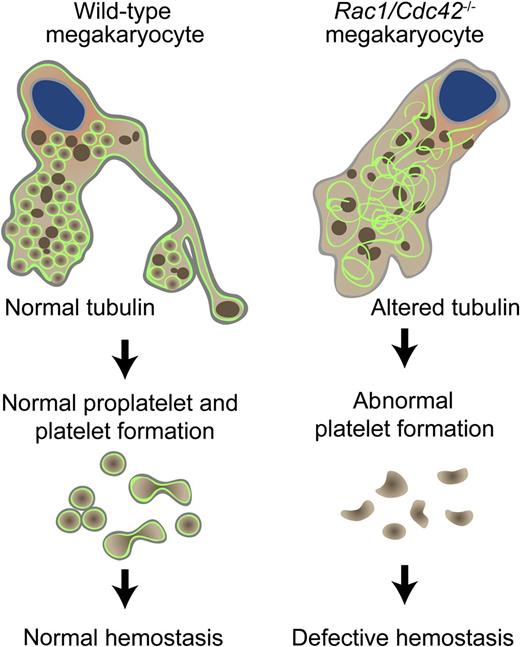In this issue of Blood, Pleines et al demonstrate that the Rho GTPase family members Rac1 and Cdc42 work together to mediate cytoskeletal activities that underlie the normal production of functional platelets by megakaryocytes.1
Pleines and colleagues describe alterations in platelet production and function in mice with megakaryocyte-specific double knockout deletions of Rac1 and Cdc42. Rac1/Cdc42−/− megakaryocytes show normal actin (brown) with abnormal microtubule structures (green) and an associated inability to form functional platelets required for hemostasis.
Pleines and colleagues describe alterations in platelet production and function in mice with megakaryocyte-specific double knockout deletions of Rac1 and Cdc42. Rac1/Cdc42−/− megakaryocytes show normal actin (brown) with abnormal microtubule structures (green) and an associated inability to form functional platelets required for hemostasis.
Platelets, the anucleate progeny of bone marrow megakaryocytic cells, are well known as the primary cellular agents of hemostasis.2 Pioneering efforts over the past decade have visualized the manner in which megakaryocytes give rise to platelets through a carefully orchestrated branching, budding, and release of proplatelet appendages.3 In their later stages of maturation, megakaryocytes extend tubulin-rich branches with pod-like tips that eventually pinch off under actin-mediated contractile forces and physiological shear to form independent, functional platelets. After platelets enter the circulation, actin- and tubulin-based cytoskeletal processes serve continued roles in platelet function, regulating secretion, aggregation, and spreading events necessary for proper hemostasis.
Given the significance of cytoskeletal dynamics to platelet production and function, an arsenal of cytoskeletal regulatory proteins, perhaps most notably the Rho GTPase family members Rac1, Cdc42, and RhoA, have emerged as critical players in megakaryocyte and platelet physiology.4 The Rho GTPase proteins are best known for coordinating changes in the actin cytoskeleton during processes of cell migration and differentiation.5 Classical cell biological studies demonstrate that RhoA mediates actin stress fiber formation while Cdc42 and Rac work to form actin-rich, finger-like filopodial protrusions and lamellipodial sheets, respectively. These generalized functions ascribed to Rho GTPase family members are also apparent, in part, in hematologic systems. For instance, megakaryocyte-specific deletions of RhoA result in defective platelet production and marked thrombocytopenia.6 In platelets, RhoA expression is required for platelet shape changes and secretion. Similar to its roles in nucleated cells, Rac1 is essential for lamellipodia formation in platelets.7 The roles of Cdc42 in platelet production and function are more complex,8 perhaps owing to overlapping redundancies in Rho GTPase signaling processes.
In the current study, to better define the potential overlapping functions of the Rho GTPases in platelets, Pleines and colleagues developed mice with double knockout megakaryocyte-specific deletions of Cdc42 in combination with Rac1. Unlike mice with megakaryocytes lacking only Cdc42 or only Rac1, mice with Rac1/Cdc42−/− double knockout megakaryocytes display severe thrombocytopenia, forming only ∼25% of the numbers of platelets relative to wild-type mice. Interestingly, actin structures appear mostly normal in Rac1/Cdc42−/− megakaryocytes and proplatelets. However, tubulin organization is disrupted and microtubule stabilization is severally compromised. Unlike wild-type maturing megakaryocytes that seemingly dangle newly forming platelets like bundles of grapes off of tubulin-rich vines, Rac1/Cdc42−/− megakaryocytes have thick, interwoven tubulin branches largely devoid of proplatelet pseudopods (see figure). As Rac1 and Cdc42 are apparently not required for the early stages of megakaryocyte maturation, Pleines et al hypothesize that Rac1 and Cdc42 work together to coordinate the final stages of platelet formation from megakaryocyte proplatelet appendages.
The relatively few platelets that form from Rac1/Cdc42−/− megakaryocytes have notable morphologic and functional abnormalities. Rac1/Cdc42−/− platelets are typically larger in size than wild-type platelets and lack the characteristic ring-like marginal band of tubulin that scaffolds the periphery of normal platelets. Similar to platelets from β-tubulin–null megakaryocytes, Rac1/Cdc42−/− platelets have an abnormal distribution of granules, suggesting that vesicle sorting is disrupted in Rac1/Cdc42−/− platelets in a manner that phenocopies tubulin deletions. Moreover, Rac1/Cdc42−/− platelets have decreased expression of several platelet surface proteins and receptors, suggesting that the trafficking of these proteins to the platelet surface is also compromised. Nonetheless, Rac1/Cdc42−/− platelets readily adhere to fibrinogen surfaces and extend filopodia, but fail to form lamellipodia in response to glycoprotein VI/immunoreceptor tyrosine-based activation motif stimulation in a manner similar to Rac1-null platelets. The authors conclude that dramatic reductions in platelet numbers together with platelet function deficits lead to hemostatic defects as well as a protection from thrombus formation in response to injury in Rac1/Cdc42−/− mice.
Although it is now clear that there is a dual requirement for Rac1 and Cdc42 for proper platelet production and function, the manner in which these Rho GTPase family members work together to regulate platelet physiology remains unknown. For instance, Rac1 and Cdc42 may coordinate platelet formation through spatially and temporally distinct signaling events, or, conversely, may colocalize and work simultaneously to regulate platelet formation. Along these lines, Rac and Cdc42 can converge on the p21-activated kinase (PAK) system to regulate numerous aspects of cellular function and PAK has recently been shown to have roles in platelet function.9 Interestingly, Rac1/Cdc42−/− platelets have no detectable activated PAK, but do show an upregulation of activity of the PAK effector LIMK1 which regulates actin dynamics through cofilin phosphorylation. Although such systems traditionally regulate actin-based processes, Rho GTPase family members and their effectors do have emerging roles in tubulin dynamics in a number of cell systems, including platelets. For example, RhoA-deficient platelets show an altered microtubule morphology following stimulation, suggesting that RhoA-based pathways contribute to platelet activation in part through tubulin regulation.6 Rather than simply regulating actin or tubulin remodeling, studies such as that of Pleines et al raise the more intriguing possibility that actin and tubulin dynamics are not independent but rather work in concert through the careful coordination of shared regulators and effectors.
Conflict-of-interest disclosure: The authors declare no competing financial interests.


This feature is available to Subscribers Only
Sign In or Create an Account Close Modal